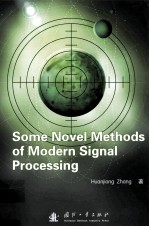
- 作 者:张焕炯著
- 出 版 社:北京:国防工业出版社
- 出版年份:2014
- ISBN:9787118095913
- 标注页数:233 页
- PDF页数:248 页
请阅读订购服务说明与试读!
订购服务说明
1、本站所有的书默认都是PDF格式,该格式图书只能阅读和打印,不能再次编辑。
2、除分上下册或者多册的情况下,一般PDF页数一定要大于标注页数才建议下单购买。【本资源248 ≥233页】
图书下载及付费说明
1、所有的电子图书为PDF格式,支持电脑、手机、平板等各类电子设备阅读;可以任意拷贝文件到不同的阅读设备里进行阅读。
2、电子图书在提交订单后一般半小时内处理完成,最晚48小时内处理完成。(非工作日购买会延迟)
3、所有的电子图书都是原书直接扫描方式制作而成。
Chapter 1 Introduction 1
1.1 Summaries of modern signal processing 1
1.2 Characters analysis of the treating methods in modern signal processing 4
1.3 Characters and construction arrangements of this book of monograph 7
1.4 Summary of this chapter 10
Chapter 2 Some novel methods under the conditions of the structural interferences 11
2.1 Introduction 11
2.2 Analysis the influence of the receiving signals with structural interferences under the conditions between synchronous and asynchronous 24
2.2.1 The model of receiving signal 27
2.2.2 Analysis the structure of the baseband signal under the synchronous and asynchronous receiving conditions 29
2.2.3 Analysis of signal structure under the synchronous and asynchronous conditions of the carrier Phase 38
2.2.4 Analysis of the numerical simulation 43
2.2.5 Summary of this section 47
2.3 Analysis of the united detective methods base on the theory of the definite linear operator 47
2.3.1 System rodel 48
2.3.2 Related conclusions of the definite linear operator theory and the application in the united detection 50
2.3.3 The united detective method based on the theory of definite linear operator under the non-strict power control 52
2.3.4 Realization and correlated performances analysis 55
2.3.5 Two examples 59
2.3.6 Simulative analysis 65
2.3.7 the Summary in this section 68
2.4 The united detection based on solving the reverse of hermite matrix 68
2.4.1 The realization of the united detective method based on the theory of hermite matrix 69
2.4.2 Computing complexity analysis and simulation 72
2.4.3 The summary of this section 73
2.5 The novel decorrelating decision feedback united detective method 74
2.5.1 System model 74
2.5.2 Derivation of new decorrelating decision feedback method 76
2.5.3 Simulation analysis and case 78
2.5.4 The summary of this section 81
2.6 A novel united detective method under the asynchronous receiving condition 82
2.6.1 Introduction 82
2.6.2 Signal model 83
2.6.3 The derivation of this new united detective method 85
2.6.4 Properties analysis and simulation 88
2.6.5 The conclusion of this section 90
2.7 Blind united detective technologies 91
2.7.1 Introduction 91
2.7.2 The common model of the blind united detection 92
2.7.3 Some concrete blind united detective methods 93
2.7.4 The summary of this section 99
2.8 The diversity technology based on the fractional Fourier Transformation 101
2.8.1 Introduction 101
2.8.2 Some corresponding theoretical conclusions of fractional Fourier Transformation 102
2.8.3 The concrete analysis of the diversity realization based on the theory of FRFT 105
2.8.4 A cryptosystem scheme based on the theory of FRFT 107
2.8.5 The summary of this section 109
2.9 A modified method of delta modulation 109
2.9.1 Introduction 109
2.9.2 Delta modulation principle analysis 110
2.9.3 Derivation of the modified delta modulation method 112
2.9.4 Property analysis and an example 114
2.9.5 Conclusion of this section 115
2.10 Summary of this chapter 116
References 117
Chapter 3 Some novel methods of modern signal processing based on Information Theories 125
3.1 Introduction 126
3.2 Some conclusions in theories of information 129
3.2.1 Some basic conceptions 129
3.2.2 Some related properties of Shannon entropy and discrimination entropy 140
3.2.3 Some important principles and criteria 147
3.3 Signal detective models based on the information extreme value criteria 151
3.3.1 Signal detective model based on the maximum entropy criterion 152
3.3.2 Signal detective model based on the minimum discrimination entropy criterion 155
3.3.3 Signal detective model based on the minimum error entropy criterion 158
3.4 Analysis of some concrete examples 162
3.4.1 Application in the domain of spectra estimation 163
3.4.2 Application in the field of blind source separation 166
3.4.3 Analysis of the example based on the criterion of the minimum error entropy 173
3.5 Conception of information matched filtering 174
3.6 Summary of this chapter 179
References 180
Chapter 4 Some new methods about signal analysis based on the theories of abstract algebra 182
4.1 Introduction 182
4.2 The basic ideas and models of the signal classification,detection and recognition 185
4.3 New methods of signal classification,detection and recognition based on group theory 188
4.3.1 The related conceptions and conclusions of group theory 188
4.3.2 The concrete application in the domain of signal classification,detection and pattern recognition 194
4.3.3 Analysis of a concrete example 200
4.4 Some novel methods of signal classification,signal detection and pattern recognition based on the theories of ring and field 202
4.4.1 The definition and related properties of ring 202
4.4.2 Some related properties of field structure 205
4.4.3 the concrete application in the domains of signal classification,detection and recognition 207
4.4.4 An example analysis based on field theory 208
4.5 The current methods of signal classification,detection and pattern recognition based on the common algebra theories 210
4.6 A novel methods based on the theory of linear operator semigroup 212
4.6.1 The related theory of linear operator semigroup 212
4.6.2 The concrete processing based on theories of linear operator semigroup 215
4.7 Summary of this chapter 219
References 220
Chapter 5 Conclusions and Prospects 222
5.1 The conclusions of the whole book monograph 222
5.2 The expectation of the future researching 227
References 229
Postscript 230
Brief Introduction about this Book of Monograph 232
